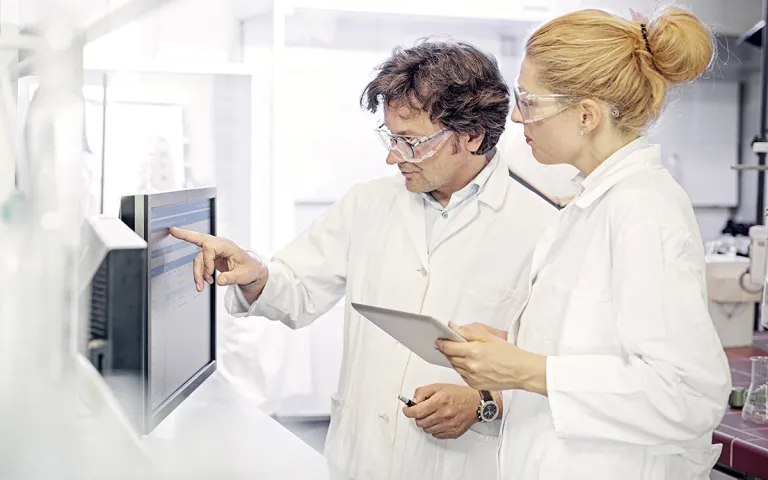Lab Equipment Management
Automated Instrument Data Acquisition and Metrology
Direct Instrument Integration and Data Capture
Connectivity is a key element of the lab of the 21st century, and the integration of equipment plays a central role in order to remove time-consuming, error-prone non-value adding manual data transfer between systems and instruments. This requires a high degree of standardization as laboratories typically have a large variety of instruments of different vendors that generate a plethora of different data formats and meta data.
Laboratories also need to manage the qualification, validation and maintenance of the instruments themselves to ensure they are fit for use for the different applications. Ideally these logbooks are connected to laboratory landscape so metrology checks can be done directly when selecting them for tests.
BIOVIA ONE Lab includes comprehensive automated instrument data acquisition and the management of instrument-related data and workflows. ONE Lab provides scientists with easy and intuitive transfer of instrument data into other systems. BIOVIA Equipment Management can be configured to automatically parse data from instrument data files into standardized formats to make results useable across systems. Auto-mapping of measurements to samples makes the import of results easy for the scientist and reduces transcription errors. By leveraging the included equipment registry, measurement store, reference data taxonomies and metrology capabilities, customers will be able to improve data consistency and integrity and improve lab productivity.
Leave No Data Behind
ONE Lab can connect most common lab instruments, including:
- Direct result transfer from simple equipment such as balances, pH meters, etc. (requires TCP/IP network connection)
- File transfer of equipment that outputs result files. Acquisition and parsing of this data is automated via directory crawling and parsing jobs
- Bidirectional data transfer with Web service-based equipment software such Chromatographic Data Systems (CDS) like Waters® Empower® and Thermo Fisher Scientific® Chromeleon®, which are available as BIOVIA CDS Add-Ins
Instrument data can be automatically included in ELN experiments, or in other tests and procedures executed in ONE Lab. Metrology checks can be performed directly from ONE Lab, making lab workflows efficient and reliable. Scientists enjoy a seamless experience with both automated instrument data acquisition and an integrated overview of instrument readiness for their experiments.
- Benefits
- Capabilities
Benefits of Integrated Equipment Management
- Achieve data integrity and veracity through direct traceable data transfer
- Increase productivity by eliminating manual data transfer
- Improve data quality by eliminate transcription errors
- Eliminate the need for 2nd scientist verification of manually entered data
- Ensure data consistency by aligning with industry standard ontologies and taxonomies
- Rely on valid state of equipment used by metrology checks during recipe execution
ONE Lab Equipment Integration Capabilities
- Manage registry of equipment including metrology status
- Automatically acquire and parse equipment data for later use
- Easily transfer measurement data into the scientist’s experiment session
- Maintain traceability of instrument data from the source to the system where data are recorded or consumed
- Track metrology events including required preventative maintenance, calibration and verification events
- Link metrology events to methods and recipes like in BIOVIA Capture to ensure the correct procedure is followed
- Audit trail for all equipment records
- Electronic logbook of equipment use and metrology events
Join the conversation in the BIOVIA Laboratory Informatics User Community!
Also Discover
Learn What BIOVIA Can Do for You
Speak with a BIOVIA expert to learn how our solutions enable seamless collaboration and sustainable innovation at organizations of every size.
Get Started
Courses and classes are available for students, academia, professionals and companies. Find the right BIOVIA training for you.
Get Help
Find information on software & hardware certification, software downloads, user documentation, support contact and services offering







